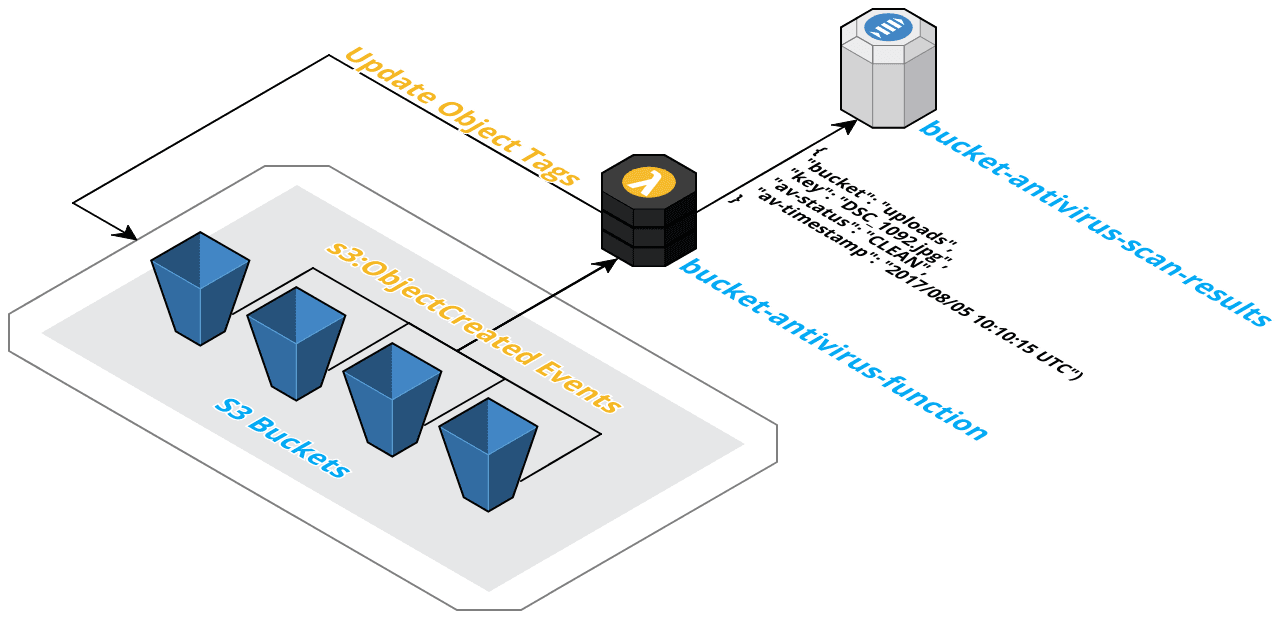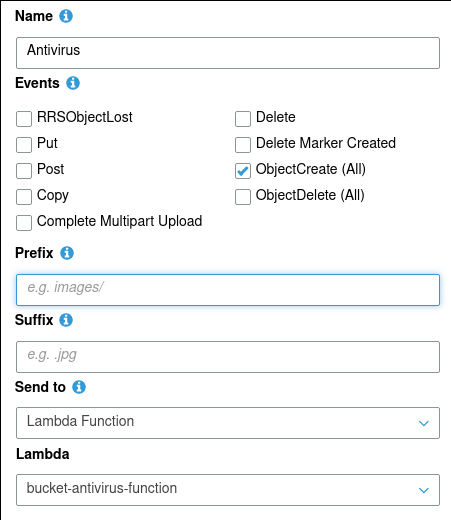Scan new objects added to any s3 bucket using AWS Lambda. more details in this post
- Easy to install
- Send events from an unlimited number of S3 buckets
- Prevent reading of infected files using S3 bucket policies
- Accesses the end-user’s separate installation of open source antivirus engine ClamAV
- Each time a new object is added to a bucket, S3 invokes the Lambda function to scan the object
- The function package will download (if needed) current antivirus definitions from a S3 bucket. Transfer speeds between a S3 bucket and Lambda are typically faster and more reliable than another source
- The object is scanned for viruses and malware. Archive files are extracted and the files inside scanned also
- The objects tags are updated to reflect the result of the scan, CLEAN or INFECTED, along with the date and time of the scan.
- Object metadata is updated to reflect the result of the scan (optional)
- Metrics are sent to DataDog (optional)
- Scan results are published to a SNS topic (optional) (Optionally choose to only publish INFECTED results)
- Files found to be INFECTED are automatically deleted (optional)
To build the archive to upload to AWS Lambda, run make. The build process is completed using
the amazonlinux Docker
image. The resulting archive will be built at build/lambda.zip. This file will be
uploaded to AWS for both Lambda functions below.
Create an s3 bucket to store current antivirus definitions. This provides the fastest download speeds for the scanner. This bucket can be kept as private.
To allow public access, useful for other accounts, add the following policy to the bucket.
{
"Version": "2012-10-17",
"Statement": [
{
"Sid": "AllowPublic",
"Effect": "Allow",
"Principal": "*",
"Action": [
"s3:GetObject",
"s3:GetObjectTagging"
],
"Resource": "arn:aws:s3:::<bucket-name>/*"
}
]
}This function accesses the user’s ClamAV instance to download
updated definitions using freshclam. It is recommended to run
this every 3 hours to stay protected from the latest threats.
-
Create the archive using the method in the Build from Source section.
-
From the AWS Lambda Dashboard, click Create function
-
Choose Author from scratch on the Create function page
-
Name your function
bucket-antivirus-updatewhen prompted on the Configure function step. -
Set Runtime to
Python 2.7 -
Create a new role name
bucket-antivirus-updatethat uses the following policy document{ "Version":"2012-10-17", "Statement":[ { "Effect":"Allow", "Action":[ "logs:CreateLogGroup", "logs:CreateLogStream", "logs:PutLogEvents" ], "Resource":"*" }, { "Action":[ "s3:GetObject", "s3:GetObjectTagging", "s3:PutObject", "s3:PutObjectTagging", "s3:PutObjectVersionTagging" ], "Effect":"Allow", "Resource":"arn:aws:s3:::<bucket-name>/*" } ] } -
Click next to go to the Configuration page
-
Add a trigger from the left of CloudWatch Event using
rate(3 hours)for the Schedule expression. Be sure to check Enable trigger -
Choose Upload a ZIP file for Code entry type and select the archive downloaded in step 1.
-
Add a single environment variable named
AV_DEFINITION_S3_BUCKETand set its value to the name of the bucket created to store your AV definitions. -
Set Lambda handler to
update.lambda_handler -
Under Basic Settings, set Timeout to 5 minutes and Memory to 512
-
Save and test your function. If prompted for test data, just use the default provided.
-
Create the archive using the method in the Build from Source section.
-
From the AWS Lambda Dashboard, click Create function
-
Choose Author from scratch on the Create function page
-
Name your function
bucket-antivirus-function -
Set Runtime to
Python 2.7 -
Create a new role name
bucket-antivirus-functionthat uses the following policy document{ "Version":"2012-10-17", "Statement":[ { "Effect":"Allow", "Action":[ "logs:CreateLogGroup", "logs:CreateLogStream", "logs:PutLogEvents" ], "Resource":"*" }, { "Action":[ "s3:GetObject", "s3:GetObjectTagging", "s3:PutObjectTagging", "s3:PutObjectVersionTagging", ], "Effect":"Allow", "Resource": [ "arn:aws:s3:::<bucket-name-1>/*", "arn:aws:s3:::<bucket-name-2>/*" ] }, { "Action":[ "s3:GetObject", "s3:GetObjectTagging", ], "Effect":"Allow", "Resource": [ "arn:aws:s3:::<av-definition-s3-bucket>/*" ] }, { "Action":[ "kms:Decrypt", ], "Effect":"Allow", "Resource": [ "arn:aws:s3:::<bucket-name-1>/*", "arn:aws:s3:::<bucket-name-2>/*" ] }, { "Action":[ "sns:Publish", ], "Effect":"Allow", "Resource": [ "arn:aws:sns:::<av-scan-start>", "arn:aws:sns:::<av-status>" ] } ] } -
Click next to head to the Configuration page
-
Add a new trigger of type S3 Event using
ObjectCreate(all). -
Choose Upload a ZIP file for Code entry type and select the archive created in step 1.
-
Set Lambda handler to
scan.lambda_handler -
Add a single environment variable named
AV_DEFINITION_S3_BUCKETand set its value to the name of the bucket created to store your AV definitions. If your bucket iss3://my-bucket, the value should bemy-bucket. -
Under Basic settings, set Timeout to 5 minutes and Memory to 1024
-
Save the function. Testing is easiest performed by uploading a file to the bucket configured as the trigger in step 4.
Configure scanning of additional buckets by adding a new S3 event to invoke the Lambda function. This is done from the properties of any bucket in the AWS console.
Note: If configured to update object metadata, events must only be
configured for PUT and POST. Metadata is immutable, which requires
the function to copy the object over itself with updated metadata. This
can cause a continuous loop of scanning if improperly configured.
Runtime configuration is accomplished using environment variables. See the table below for reference.
| Variable | Description | Default | Required |
|---|---|---|---|
| AV_DEFINITION_S3_BUCKET | Bucket containing antivirus definition files | Yes | |
| AV_DEFINITION_S3_PREFIX | Prefix for antivirus definition files | clamav_defs | No |
| AV_DEFINITION_PATH | Path containing files at runtime | /tmp/clamav_defs | No |
| AV_SCAN_START_SNS_ARN | SNS topic ARN to publish notification about start of scan | No | |
| AV_SCAN_START_METADATA | The tag/metadata indicating the start of the scan | av-scan-start | No |
| AV_SIGNATURE_METADATA | The tag/metadata name representing file's AV type | av-type | No |
| AV_STATUS_CLEAN | The value assigned to clean items inside of tags/metadata | CLEAN | No |
| AV_STATUS_INFECTED | The value assigned to clean items inside of tags/metadata | INFECTED | No |
| AV_STATUS_METADATA | The tag/metadata name representing file's AV status | av-status | No |
| AV_STATUS_SNS_ARN | SNS topic ARN to publish scan results (optional) | No | |
| AV_STATUS_SNS_PUBLISH_CLEAN | Publish AV_STATUS_CLEAN results to AV_STATUS_SNS_ARN | True | No |
| AV_STATUS_SNS_PUBLISH_INFECTED | Publish AV_STATUS_INFECTED results to AV_STATUS_SNS_ARN | True | No |
| AV_TIMESTAMP_METADATA | The tag/metadata name representing file's scan time | av-timestamp | No |
| CLAMAVLIB_PATH | Path to ClamAV library files | ./bin | No |
| CLAMSCAN_PATH | Path to ClamAV clamscan binary | ./bin/clamscan | No |
| FRESHCLAM_PATH | Path to ClamAV freshclam binary | ./bin/freshclam | No |
| DATADOG_API_KEY | API Key for pushing metrics to DataDog (optional) | No | |
| AV_PROCESS_ORIGINAL_VERSION_ONLY | Controls that only original version of an S3 key is processed (if bucket versioning is enabled) | False | No |
| AV_DELETE_INFECTED_FILES | Controls whether infected files should be automatically deleted | False | No |
| EVENT_SOURCE | The source of antivirus scan event "S3" or "SNS" (optional) | S3 | No |
This policy doesn't allow to download the object until:
- The lambda that run Clam-AV is finished (so the object has a tag)
- The file is not CLEAN
Please make sure to check cloudtrail for the arn:aws:sts, just find the event open it and copy the sts. It should be in the format provided below:
{
"Effect": "Deny",
"NotPrincipal": {
"AWS": [
"arn:aws:iam::<<aws-account-number>>:role/<<bucket-antivirus-role>>",
"arn:aws:sts::<<aws-account-number>>:assumed-role/<<bucket-antivirus-role>>/<<bucket-antivirus-role>>",
"arn:aws:iam::<<aws-account-number>>:root"
]
},
"Action": "s3:GetObject",
"Resource": "arn:aws:s3:::<<bucket-name>>/*",
"Condition": {
"StringNotEquals": {
"s3:ExistingObjectTag/av-status": "CLEAN"
}
}
}{
"Version": "2012-10-17",
"Statement": [
{
"Effect": "Deny",
"Action": ["s3:GetObject", "s3:PutObjectTagging"],
"Principal": "*",
"Resource": ["arn:aws:s3:::<<bucket-name>>/*"],
"Condition": {
"StringEquals": {
"s3:ExistingObjectTag/av-status": "INFECTED"
}
}
}
]
}You may want to scan all the objects in a bucket that have not previously been scanned or were created
prior to setting up your lambda functions. To do this you can use the scan_bucket.py utility.
pip install boto3
scan_bucket.py --lambda-function-name=<lambda_function_name> --s3-bucket-name=<s3-bucket-to-scan>This tool will scan all objects that have not been previously scanned in the bucket and invoke the lambda function asynchronously. As such you'll have to go to your cloudwatch logs to see the scan results or failures. Additionally, the script uses the same environment variables you'd use in your lambda so you can configure them similarly.
There are two types of tests in this repository. The first is pre-commit tests and the second are python tests. All of these tests are run by CircleCI.
The pre-commit tests ensure that code submitted to this repository meet the standards of the repository. To get started
with these tests run make pre_commit_install. This will install the pre-commit tool and then install it in this
repository. Then the github pre-commit hook will run these tests before you commit your code.
To run the tests manually run make pre_commit_tests or pre-commit run -a.
The python tests in this repository use unittest and are run via the nose utility. To run them you will need
to install the developer resources and then run the tests:
pip install -r requirements-dev.txt
make testUpside Travel, Inc.
Licensed under the Apache License, Version 2.0 (the "License");
you may not use this file except in compliance with the License.
You may obtain a copy of the License at
http://www.apache.org/licenses/LICENSE-2.0
Unless required by applicable law or agreed to in writing, software
distributed under the License is distributed on an "AS IS" BASIS,
WITHOUT WARRANTIES OR CONDITIONS OF ANY KIND, either express or implied.
See the License for the specific language governing permissions and
limitations under the License.
ClamAV is released under the GPL Version 2 License and all source for ClamAV is available for download on Github.

